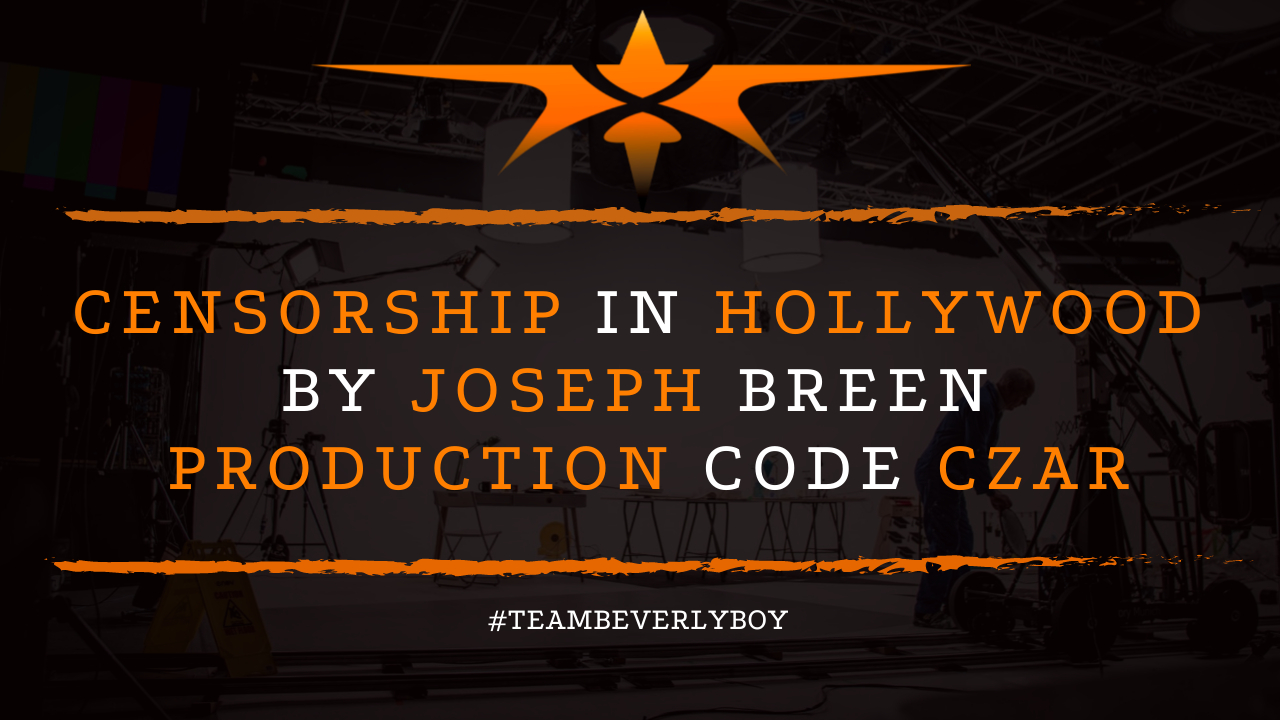
Censorship in Hollywood by Joseph Breen Production Code Czar
According to history books and of course to film historians Joseph Breen, was a production code czar who established powerful censorship. Which guided the film industry for the next two decades. Originally appointed by Will Hays to assist the film industry in censoring itself. The idea that if censorship’s done right? There would be no need for government censorship in Hollywood as long as things went according to the plan set forth by Hays and Breen.

Production Code Administration, which was responsible for the censorship of indecent and vulgar materials from films, would be Breen’s focus for twenty years.
During that time, not only would Joseph Breen be one of Hollywood’s most powerful people!
But his development of moral guidelines and practices in the Production Code Administration would ultimately shape the American film industry for the next two decades.
Who Was Joseph Breen, Production Code Czar?
Joseph Breen, Production Code Administration’s Head, was a prominent Catholic layman that had long worked in public relations.
He was appointed the head of the organization in 1934 and would ultimately finish out his career there before retiring twenty years later in 1954.
During Breen’s time as the leader of the Production Code Administration, he would rigorously enforce the Production Code. In fact, enforcement was so rigid during his tenure that many famous films.
Including cartoons, would have to change their characters, lines, scenes, or various other elements due to failing to meet or follow the “rules.”
Rewriter
Breen had the power to change scripts and scenes. In order to accommodate the censorship set forth by the Production Code.
Although this angered the screenwriters and producers involved in the filmmaking, there was nothing they could do at the time.
Thus, for two decades, Breen would become one of the most recognized people in Hollywood, but not necessarily the most appreciated or liked!
What Was the Production Code?
The Production Code were a representation of very specific restrictions on the type of language and behavior that the film industry restricted.
Particularly, sex and crime, would render a film invalid for box office sales as would nudity, illicit drug use, childbirth, and any ridicule of religion.
The Production Code further went on to censor films to the extent that murder scenes were to never show brutality in full-detail and of course were not to encourage imitation in any capacity.
The Nuclear Family Image
Additionally, the Production Code respected the sanctity of marriage and required that films uphold the sacristy of the home.
There were no excuses nor was there any room in the film industry for films that incorporated certain “offensive” words or phrases.
Such as:
- Pregnant (this was seen as “vulgar” and on I Love Lucy the word was actually replaced with the word “expecting” at one time).
- God, Lord, Jesus, Christ, Hell & Damn (could not be used unless they were used in direct connection to religious ceremonies).
- Virgin (this word was unacceptable because it referenced sexual behavior).
An Extensive List
The list of censorship resulting from the Production Code was incredibly extensive and included many different rules and regulations.
Which resulted in so many films being changed in order to accommodate the “code.”
In addition to the details listed above, the Production Code also:
- Required U.S. flags to be treated with respect but paid little mind to other flags.
- Stated that religion, particularly the Christian faith, could not be mocked in any way.
- Did not allow for nudity or references to sexual behavior.
- Banned any films that did not respect the law or which represented instances in which the law was not upheld.
- Did not allow topics that were considered “perverse” to be depicted in any way. (For the purpose of the “Code,” the following topics were considered perverse: homosexuality, interracial relationships, bestiality).
Decline of Breen Production Code Administration
Although there were two decades of Breen’s administration which would result in the censoring of many films throughout the industry.
Eventually the film industry would begin to face some powerfully competitive threats. Technology was improving, televisions were now becoming more widely available.
And people no longer had to leave home in order to see a show. Not only that, but foreign films would also begin to enter the U.S.
Less Restrictive
Many of them were far less restricted by censorship codes. And thus, were able to deliver an entirely unique form of entertainment.
Hollywood had no way of eliminating these films from rotation. Despite their open violation of the Production Code.
Fighting Back
Filmmakers would soon begin to gain the courage to fight back once again against film censorship in the industry.
With domestic filmmakers mounting some pretty serious challenges against the “Code”.
Joseph Breen, Production Code Administration Head for two-decades, would begin to tire and start to plan for retirement.
Thus, in February of 1954, some twenty years after the appointment of Joseph Breen to the head of the Production Code Administration, he would retire from his position.
The Remainder of Hays Code
The Hays Production Code would continue to elicit censorship throughout Hollywood for almost twenty more years.
Before it would be replaced by the Motion Picture Association of America (MPAA) film ratings system.
The new ratings system would establish a system that allowed parents to guide their decisions as to what movies would, or would not, be appropriate for their children.
Based on the appropriateness of content within the film.
The MPAA
The rating’s system is not a legal requirement for filmmakers the way the prior Production Code censorship and actually does not “censor” films at all.
However, some theaters will not distribute a film that is unrated. And therefore, there could be potential economic limitations or sanctions.
Which result from a filmmaker’s failure to apply for rating. Instead, each film that is submitted for MPAA rating will receive a rating such as P, PG, PG-13, R and X.
These ratings allow spectators to decide which films are potentially appropriate for their viewing based on the anticipated material within the film and how it has been rated.
In the End
As for Joseph Breen, Production Code Administration department head, he passed away ten years after he retired from his position.
But his name would become a legacy in the film industry which would not soon be forgotten.


